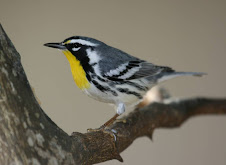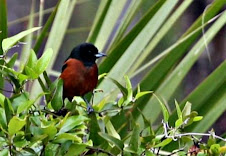
Wilson's Storm-petrel
I went on my first pelagic trip last Saturday, with Andy as one of the leaders. It was amazing. I couldn't believe the way the leaders were identifying the different birds at 50-200 yards! I only got good looks at five of the species: Black-capped petrel, Wilson's Storm-petrel, Audubon's Shearwater, Bridled and Sooty terns. The official list was amazing. What was really surprising were the warblers and dove that flew around the boat fifty+ miles out. These are the best pictures I got. (I had enough trouble trying to focus my binoculars!)Maybe Andy will post some better pictures. Hint, hint!
Carol Miller
Black-capped Petrel
Sorry Carol, I did not take my camera with me as it's hard getting good photographs especially when I'm trying to show other people where the birds are, however I did take my video camera and made a short movie of the songbirds we encountered on the trip.
The day began at 345am when we set sail out of New Smyrna and headed due east for the Gulf Stream. Like Carol said we encountered a Eurasian Collared-dove 50 miles offshore! Very lost! Our first seabirds were Bridled Terns followed by Audubon's Shearwaters but once in the Gulf Stream (60 miles offshore) we saw several Black-capped Petrels, the species we all wanted to see. These F-16's of the ocean made flying seem effortless as they shot by the boat flying in huge cyclic arcs. Wilson's and Band-rumped Storm-petrels followed the boat attracted by a slick of menhaden oil mixed with chopped sardines and popcorn. Out beyond the Gulf Stream we came across a large flock of noisy Sooty Terns; they put on a great show!
As Carol mentioned we saw many songbirds, some of which were 70-90 miles offshore heading north on their spring migration. Perhaps the most amazing was a Black-billed Cuckoo..75 miles out! Both American Redstart and Common Yellowthroat accompanied us for much of the journey but sadly a Blackpoll Warbler didn't make it. Boblinks also flew by!
Marine mammals such as Spotted Dlphin and Short-finned Pilot Whales were enjoyed as well as an enormous Loggerhead Turtle, a Hammerhead Shark and White Marlin.
Andy
.jpg)





























